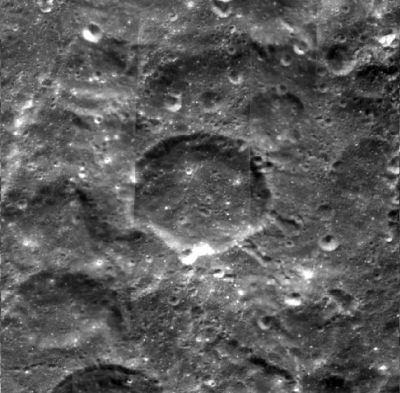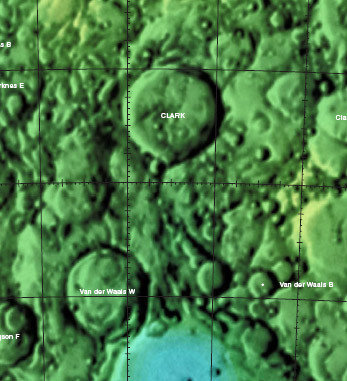Difference between revisions of "Clark"
(Created page with "<div id="content_view" class="wiki" style="display: block"> =Clark= {| class="wiki_table" | Lat: 38.4°S, Long: 118.9°E, Diam: 49 km, Depth: km, Rükl: ''(farside)''<br />...") |
|||
| Line 9: | Line 9: | ||
[[Image:clark-color.jpg|clark-color.jpg]]<br /> | [[Image:clark-color.jpg|clark-color.jpg]]<br /> | ||
|} | |} | ||
| − | '''Left:''' ''[http://www.mapaplanet.org/explorer-bin/explorer.cgi?map=Moon&layers=moon_clementine_base_v2&info=NO&advoption=YES&sizeSelector=imageSize&lines=724&samples=1440&Resolution=57.0300157977882&r=1&g=1&b=1&projection=SIMP&grid=none&stretch=auto&north=-42.31&south=-35.98&west=113.31&east=125.93¢er_lat=0¢er=119.62&defaultcenter=on Clementine] image. '''Right:'''[http://planetarynames.wr.usgs.gov/images/Lunar/lac_117.pdf Color-coded Topography LAC 117] image from [http://the-moon. | + | '''Left:''' ''[http://www.mapaplanet.org/explorer-bin/explorer.cgi?map=Moon&layers=moon_clementine_base_v2&info=NO&advoption=YES&sizeSelector=imageSize&lines=724&samples=1440&Resolution=57.0300157977882&r=1&g=1&b=1&projection=SIMP&grid=none&stretch=auto&north=-42.31&south=-35.98&west=113.31&east=125.93¢er_lat=0¢er=119.62&defaultcenter=on Clementine] image. '''Right:'''[http://planetarynames.wr.usgs.gov/images/Lunar/lac_117.pdf Color-coded Topography LAC 117] image from [http://the-moon.us/wiki/USGS%20Digital%20Atlas USGS Digital Atlas].''<br /> <div id="toc"> |
=Table of Contents= | =Table of Contents= | ||
<div style="margin-left: 1em">[#Clark Clark]</div><div style="margin-left: 2em">[#Clark-Images Images]</div><div style="margin-left: 2em">[#Clark-Maps Maps]</div><div style="margin-left: 2em">[#Clark-Description Description]</div><div style="margin-left: 2em">[#Clark-Description: Wikipedia Description: Wikipedia]</div><div style="margin-left: 2em">[#Clark-Additional Information Additional Information]</div><div style="margin-left: 2em">[#Clark-Nomenclature Nomenclature]</div><div style="margin-left: 2em">[#Clark-LPOD Articles LPOD Articles]</div><div style="margin-left: 2em">[#Clark-Bibliography Bibliography]</div><div style="margin-left: 2em">[#Clark-Alvan Clark in the Sourcebook Project (William R. Corliss) Alvan Clark in the Sourcebook Project (William R. Corliss)]</div></div> | <div style="margin-left: 1em">[#Clark Clark]</div><div style="margin-left: 2em">[#Clark-Images Images]</div><div style="margin-left: 2em">[#Clark-Maps Maps]</div><div style="margin-left: 2em">[#Clark-Description Description]</div><div style="margin-left: 2em">[#Clark-Description: Wikipedia Description: Wikipedia]</div><div style="margin-left: 2em">[#Clark-Additional Information Additional Information]</div><div style="margin-left: 2em">[#Clark-Nomenclature Nomenclature]</div><div style="margin-left: 2em">[#Clark-LPOD Articles LPOD Articles]</div><div style="margin-left: 2em">[#Clark-Bibliography Bibliography]</div><div style="margin-left: 2em">[#Clark-Alvan Clark in the Sourcebook Project (William R. Corliss) Alvan Clark in the Sourcebook Project (William R. Corliss)]</div></div> | ||
| Line 15: | Line 15: | ||
[http://www.lpod.org/coppermine/thumbnails.php?album=search&type=full&search=Clark LPOD Photo Gallery] [http://www.lpi.usra.edu/resources/lunar_orbiter/bin/srch_nam.shtml?Clark%7C0 Lunar Orbiter Images] [http://www.lpi.usra.edu/resources/apollo/search/feature/?feature=Clark Apollo Images]<br /> Apollo 17's ''Fairchild''-camera photograph [http://www.lpi.usra.edu/resources/apollo/frame/?AS17-M-3183 AS17-M-3183] (made during Trans Earth Coast, TEC) shows '''Clark''' near the frame's upper margin.<br /> Research: Danny Caes<br /> <br /> | [http://www.lpod.org/coppermine/thumbnails.php?album=search&type=full&search=Clark LPOD Photo Gallery] [http://www.lpi.usra.edu/resources/lunar_orbiter/bin/srch_nam.shtml?Clark%7C0 Lunar Orbiter Images] [http://www.lpi.usra.edu/resources/apollo/search/feature/?feature=Clark Apollo Images]<br /> Apollo 17's ''Fairchild''-camera photograph [http://www.lpi.usra.edu/resources/apollo/frame/?AS17-M-3183 AS17-M-3183] (made during Trans Earth Coast, TEC) shows '''Clark''' near the frame's upper margin.<br /> Research: Danny Caes<br /> <br /> | ||
==Maps== | ==Maps== | ||
| − | ([http://the-moon. | + | ([http://the-moon.us/wiki/LAC%20zone LAC zone] 117B4) ''[http://planetarynames.wr.usgs.gov/images/Lunar/lac_117.pdf USGS Digital Atlas PDF]''<br /> <br /> |
==Description== | ==Description== | ||
'''Clark''' is a relatively worn-looking crater. Most of its rim has in the past been impacted by numerous small craters particularly in its north-eastern sector, with a very prominant one, approximatley 5 km across, in the south. The western sector of the rim hasn't escaped degradation events either, as massive slumping of material in the region has occurred, which covers approximatley a third of the floor of '''Clark''' there. A series of hills and terraces has been produced as a result, but these look worn and smooth; possibly because of further slumping -- an indication as to its makeup -- or, perhaps, due to related impact events occurring around the same time that the crater formed. The floor of '''Clark''' is flat and shows a history of numerous, small impact craters that occurred, possibly, around the same time -- they look aged and worn in appearance. One obvious, bright-looking crater just north-west of the central region shows a fresh appearance, however, an additional feature just east of this seems interesting; showing a possible, linear fault running approximately north-southwards for about 20 km -- the downside of which occurred at the western side. <span class="membersnap">- [http://www.wikispaces.com/user/view/JohnMoore2 [[Image:JohnMoore2-lg.jpg|16px|JohnMoore2]]] [http://www.wikispaces.com/user/view/JohnMoore2 JohnMoore2]</span><br /> <br /> | '''Clark''' is a relatively worn-looking crater. Most of its rim has in the past been impacted by numerous small craters particularly in its north-eastern sector, with a very prominant one, approximatley 5 km across, in the south. The western sector of the rim hasn't escaped degradation events either, as massive slumping of material in the region has occurred, which covers approximatley a third of the floor of '''Clark''' there. A series of hills and terraces has been produced as a result, but these look worn and smooth; possibly because of further slumping -- an indication as to its makeup -- or, perhaps, due to related impact events occurring around the same time that the crater formed. The floor of '''Clark''' is flat and shows a history of numerous, small impact craters that occurred, possibly, around the same time -- they look aged and worn in appearance. One obvious, bright-looking crater just north-west of the central region shows a fresh appearance, however, an additional feature just east of this seems interesting; showing a possible, linear fault running approximately north-southwards for about 20 km -- the downside of which occurred at the western side. <span class="membersnap">- [http://www.wikispaces.com/user/view/JohnMoore2 [[Image:JohnMoore2-lg.jpg|16px|JohnMoore2]]] [http://www.wikispaces.com/user/view/JohnMoore2 JohnMoore2]</span><br /> <br /> | ||
Revision as of 20:11, 11 April 2018
Contents
Clark
| Lat: 38.4°S, Long: 118.9°E, Diam: 49 km, Depth: km, Rükl: (farside) | |
Table of Contents
Images
LPOD Photo Gallery Lunar Orbiter Images Apollo Images
Apollo 17's Fairchild-camera photograph AS17-M-3183 (made during Trans Earth Coast, TEC) shows Clark near the frame's upper margin.
Research: Danny Caes
Maps
(LAC zone 117B4) USGS Digital Atlas PDF
Description
Clark is a relatively worn-looking crater. Most of its rim has in the past been impacted by numerous small craters particularly in its north-eastern sector, with a very prominant one, approximatley 5 km across, in the south. The western sector of the rim hasn't escaped degradation events either, as massive slumping of material in the region has occurred, which covers approximatley a third of the floor of Clark there. A series of hills and terraces has been produced as a result, but these look worn and smooth; possibly because of further slumping -- an indication as to its makeup -- or, perhaps, due to related impact events occurring around the same time that the crater formed. The floor of Clark is flat and shows a history of numerous, small impact craters that occurred, possibly, around the same time -- they look aged and worn in appearance. One obvious, bright-looking crater just north-west of the central region shows a fresh appearance, however, an additional feature just east of this seems interesting; showing a possible, linear fault running approximately north-southwards for about 20 km -- the downside of which occurred at the western side. - JohnMoore2 JohnMoore2
Description: Wikipedia
Additional Information
Nomenclature
- Alvan Clark (March 8, 1804 – August 19, 1887) was an American astronomer and telescope maker. His firm Alvan Clark & Sons ground lenses for refracting telescopes, including the largest in the world at the time: the 18.5-inch at Dearborn Observatory, the 26-inch at the US Naval Observatory, the 30-inch at Pulkovo Observatory, the 36-inch telescope at Lick Observatory (still third-largest) and later the 40-inch at Yerkes Observatory, which remains the largest successful refracting telescope in the world.
- Alvan Graham Clark (July 10, 1832 – June 9, 1897) was an American astronomer and telescope-maker. He was the son of Alvan Clark. In 1862, while testing Northwestern University's Dearborn Telescope in Evanston, Illinois, which was a new 18-inch refracting telescope, he discovered Sirius B, the magnitude 8 companion of Sirius and the first known white dwarf.
- There is also a craterlet called Clark at the Taurus-Littrow Valley (the landing site of Apollo 17). Lewis and Clark (Apollo 17 craters) - "William Clark and Meriwether Lewis began the American exploration of the western territories purchased from France by the young nation. Inspired by Thomas Jefferson, their explorations laid both the psychological groundwork for the future expansion of the United States in the West and the geographical basis for our growth and strength as a free nation." (source: APOLLO LUNAR SURFACE JOURNAL, Eric M. Jones).
LPOD Articles
Bibliography
Alvan Clark in the Sourcebook Project (William R. Corliss)
The mystery of the TRIANGULAR STAR DISCS - Page 576 in Mysterious Universe, a handbook of astronomical anomalies (1979) :
- A Peculiar Telescopic Phenomenon (Peter Doig, Journal of the British Astronomical Association, 1930).
This page has been edited 1 times. The last modification was made by - tychocrater tychocrater on Jun 13, 2009 3:24 pm - afx3u2//

